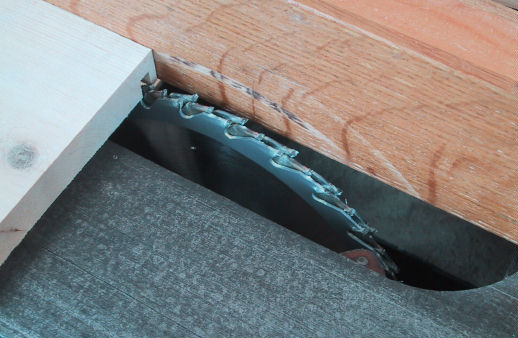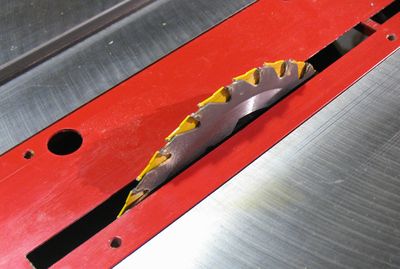
A dado by stacking cheap 7 1/2" saw blades
Given the relatively high costs of a dado set, I delayed buying such a set for a long time. With skillsaw blades selling for well under $10, I wasn't really prepared to shell out more than $100 for a proper dado set.
What I had done quite often was to just make a series of side by side cuts to approximate a dado. With a thicker saw balde, fewer cuts are necessary to remove materials. And it occured to me that maybe I should just put two sawblades on the saw side by side to remove more material. But why stop at two?
So I bought three cheap skillsaw blades. The teeth on these blades are quite a bit wider than the actual blade itself. By rotating adjacent blades by half a tooth, the teeth go into the gaps of the ajacent blades. With three blades side by side, the teeth from the two outside blades will barely not touch in the middle.
To get extra width, its possible to put shims between the blades, up to nearly a milimeter before the blades leave a piece of wood in between. This way, you can do fine adjustments for how wide your cut will be. A variety of materials work good enough for shims - I prefer sheets of plastic, mostly from packaging. Cardboard also works, although the edges can fray and then you can't rely on them to be completely flat anymore. Or you can order a set of dado shims from Lee Valley Tools.

A dado by stacking cheap 7 1/2" saw blades
Even after I bought a dado set, I still use this trick from time to time. Mostly, I use it for narrow dadoes, the kind that are either narrower than both blades of the dado stack, or of the width to be too narrow to include even one chipper in the dado stack.
 In the imag at left, fo rexample, I stacked a regular kerf skillsaw blade and a
thin kerf skillsaw blade to get a 4 mm cut.
In the imag at left, fo rexample, I stacked a regular kerf skillsaw blade and a
thin kerf skillsaw blade to get a 4 mm cut.
Finally, I wouldn't recommend stacking more than 4 blades at once. If you need a wider cut, just make successive cuts.
Also, when you go to buy the blades, take a caliper with you, and make sure they all are the same radius. I found that one of the three blades I bought had a radius that was 0.5 mm smaller than the others. It was a good blade, just with all the teeth ground slightly smaller - very annoying that way. Another old blade I had lying around was just the right size and number of teeth, so I just use that one now.
This will plug up with sawdust
I was worried about this when I first tried it too, but the best way to find out is to try it. As it turns out, chip removal has never been a problem. I think mostly because with a dado, one generally doesn't cut as deep and as fast as one would with a regular saw blade.
Safety
More Wood shop tricks